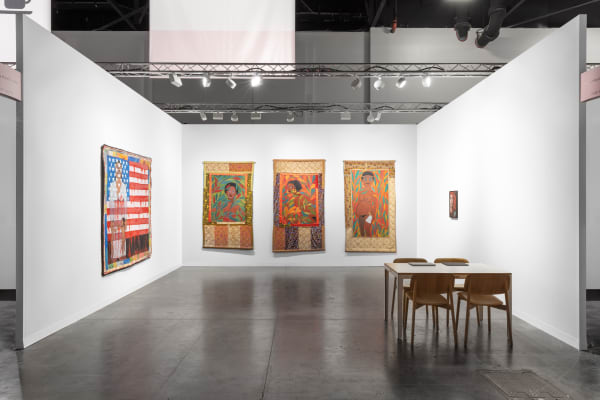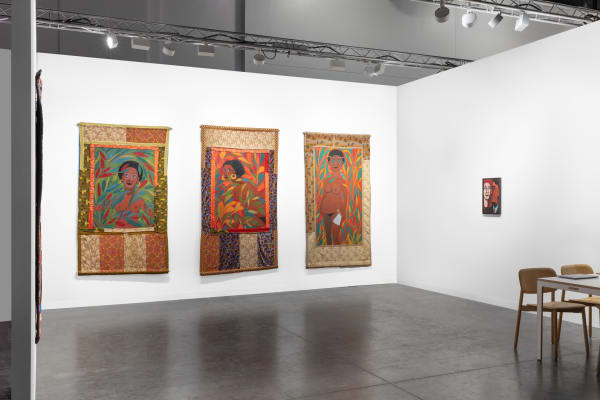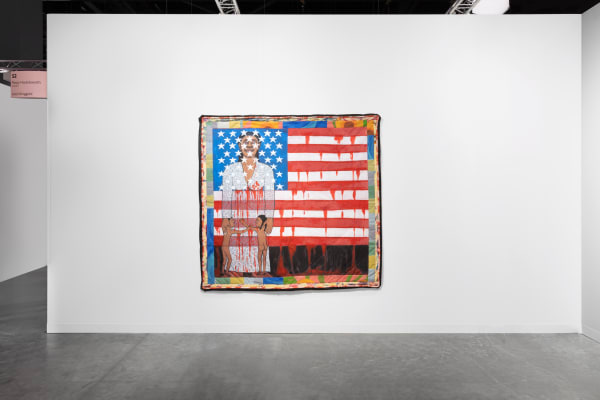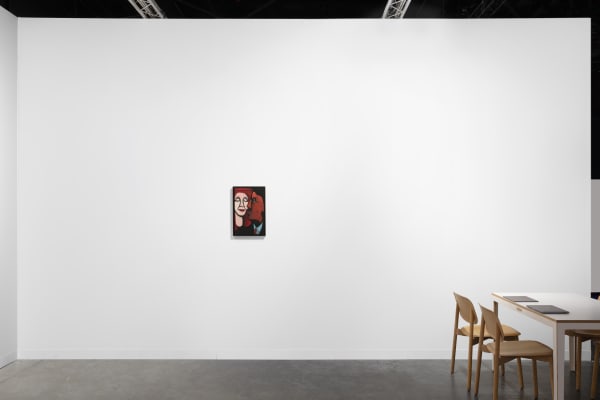Pippy Houldsworth Gallery presents a body of uniquely autobiographical work by American artist Faith Ringgold. Throughout her career, Ringgold has addressed the experience of African Americans in the US but only rarely through the lens of the self-portrait. The Survey booth will show a small selection of the artist’s most intensely political and intimately personal work: each makes reference to Ringgold’s own experiences – directly and indirectly - weaving her narrative together with the wider politics of her practice. The three major works of the Slave Rape series – presented in the US for the first time in decades – will be seen alongside the Flag is Bleeding #2 and Hide Little Children from the American People Series. Each work has previously been exhibited in significant museums. The gallery will also present a newly commissioned text.
Ringgold’s three Slave Rape paintings (1972), comprising Fear Will Make You Weak, Run You Might Get Away and Fight to Save Your Life, mark the first time Ringgold brings together issues of both race and gender within a single work. Focusing on the rape of slaves by their masters, these works mark a crucial turning point in Ringgold’s career. She depicts herself alongside her daughters as a way to comprehend her ancestors’ trauma as a precursor to her own. The three women, vulnerable in their nudity, are urged to resist and fight. They embody the past and the present – their blue eyes reveal the rape of their ancestors while their 1970s hairstyles and strong bodies point to the current empowered generation. The painting depicting the artist herself shows her pregnant and grasping an axe, active in self-defence. Significantly, these works are Ringgold’s last oil paintings and her first tankas. The works were her first collaboration with her mother who made the fabric borders thus tying together the history of her ancestors and the three current generations of her family.
Hide Little Children (1966), part of Ringgold’s iconic American People series, addresses the tension arising from desegregation and the psychological substructure of racism in daily life through the innocence of childhood. Rendered in a style that synthesises post-Cubist Picasso and traditional African sculpture and design, the flat planes of colour and thin glazes of paint also highlight the influence of Jacob Lawrence and Romare Bearden. Painted with vibrant brushstrokes, the work depicts five children, three white and two black, concealed in a forest as if playing hide-and-seek. Ringgold explains “this painting was inspired by my own children and the fears I had about their friendships with white children. Their school had a reputation for being ultra-liberal, but what about the parents?” The children stare out directly towards the viewer, symbolising the importance of witnessing in a time of ignorance and complicity.
The Flag Is Bleeding #2 (1997) reconfigures the American flag with harrowing potency; the red stripes drip with blood providing an antithetical image of the freedom and rights that the flag is meant to symbolise. Ringgold explains “Jasper Johns presented a beautiful, but incomplete idea. To complete it I wanted to show some of the hell that had broken out in the States.” Drawing an interesting parallel between the African textile border and the geometry of the flag, Ringgold said “the flag is the only subversive and revolutionary abstraction one can paint." Superimposed on the flag is an African American woman with two children hanging on to her skirt, reminiscent of Ringgold and her two daughters. She made this work as a response to The Flag Is Bleeding #1 which portrays a black man and a white man held apart by a white woman serving as the peacemaker. Ringgold explains “I didn’t put a black woman in there, because she had another role. In this work, I wanted to give her her own role. The women had to make sure the kids were taken care of, and protected.”
The artist has adapted the tradition of the American slave quilt to create a world in which the presence, often invisible, of African American women’s heroism is brought to the fore. That the artist's great-great-grandmother was born into slavery and produced quilts for plantation owners lends Ringgold's work a deeper, personal register.






